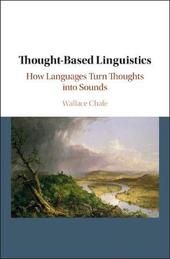
|
Thought-based Linguistics: How Languages Turn Thoughts into Sounds
Hardback
Main Details
| Title |
Thought-based Linguistics: How Languages Turn Thoughts into Sounds
|
| Authors and Contributors |
By (author) Wallace Chafe
|
| Physical Properties |
| Format:Hardback | | Pages:202 | | Dimensions(mm): Height 235,Width 158 |
|
| Category/Genre | Philosophy of language
Psycholinguistics
Semantics
Philosophy of the mind |
|---|
| ISBN/Barcode |
9781108421171
|
| Classifications | Dewey:415.01835 |
|---|
| Audience | | Professional & Vocational | |
|---|
| Illustrations |
Worked examples or Exercises; 72 Line drawings, black and white
|
|
Publishing Details |
| Publisher |
Cambridge University Press
|
| Imprint |
Cambridge University Press
|
| Publication Date |
19 April 2018 |
| Publication Country |
United Kingdom
|
Description
The extent to which language is inseparable from thought has long been a major subject of debate across linguistics, psychology, philosophy and other disciplines. In this study, Wallace Chafe presents a thought-based theory of language that goes beyond traditional views that semantics, syntax, and sounds are sufficient to account for language design. Language begins with thoughts in the mind of a speaker and ends by affecting thoughts in the mind of a listener. This obvious observation is seldom incorporated in descriptions of language design for two major reasons. First, the role of thought is usually usurped by semantics. But semantic structures are imposed on thought by languages and differ from one language to another. Second, thought does not lend itself to familiar methods of linguistic analysis. Chafe suggests ways of describing thoughts, traces the path languages follow from thoughts to sounds, and explores ways in which thoughts are oriented in time, memory, imagination, reality, and emotions.
Author Biography
Wallace Chafe is Professor Emeritus and Research Professor at the University of California, Santa Barbara. His research has focused in part on the Seneca language in New York and the Caddo language in Oklahoma. He has investigated differences between speaking and writing; the functions of prosody in spoken language; the emotion underlying laughter and humor, ways in which language can be beautiful; and relations between language and thought.
|